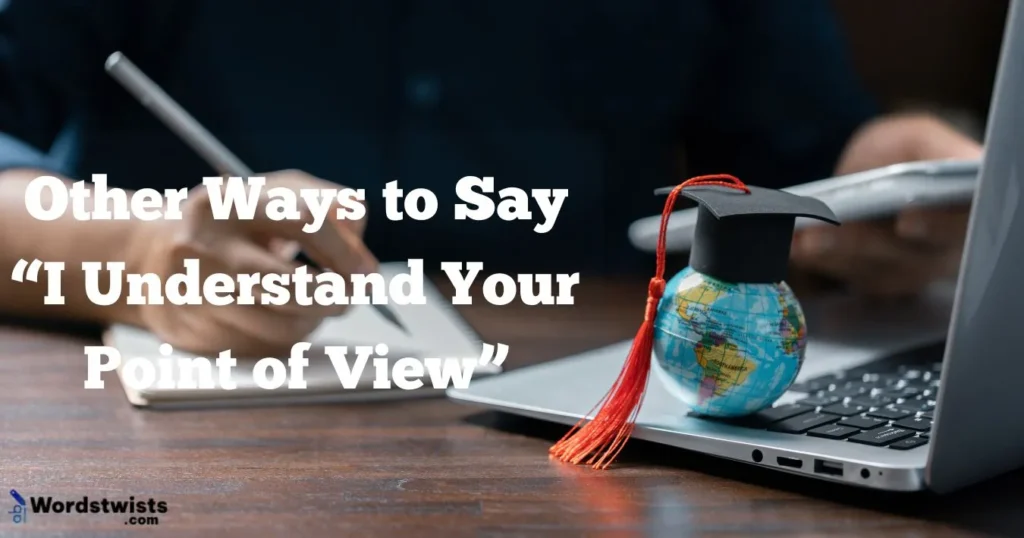Have you ever found yourself stuck using the same old phrase, “I understand your point of view,” over and over again? It’s a phrase we often reach for because it feels polite and shows we’re listening. But honestly, it can get a little dull and lose its impact when repeated too much. If you’re looking to spice up your writing or conversations, you’re in the right place!
This post will share 25 fresh and meaningful alternatives to say you get where someone is coming from—without sounding boring or robotic. Whether you want to sound more thoughtful in emails, casual in chats, or professional in meetings, these alternatives will help your words stand out with style and personality.
Using these varied expressions will not only enhance your vocabulary but also improve your communication skills by making your responses feel more genuine and engaging. So, get ready to discover new ways to show empathy, agreement, or understanding with confidence.
Dive in, and let’s explore these powerful alternatives that will make your conversations shine!
Alternatives to Say I Understand Your Point of View
1. I See Where You’re Coming From
This phrase shows empathy and openness. It’s casual yet respectful, making it perfect for both informal and professional settings. It acknowledges the other person’s position without necessarily agreeing or disagreeing.
Examples:
- I see where you’re coming from, but have you considered the budget limits?
- That’s an interesting approach—I see where you’re coming from now.
- I see where you’re coming from, and it helps me understand your concerns better.
- Thanks for explaining; I see where you’re coming from with this idea.
- I see where you’re coming from, and I think we can find a middle ground.
Why It Works:
It conveys genuine understanding and respect without sounding too formal or mechanical. The phrase invites further dialogue by showing active listening.
2. I Get Your Perspective
Simple and direct, this phrase clearly communicates that you comprehend someone’s viewpoint. It feels approachable and shows you’re engaged.
Examples:
- I get your perspective on the project timeline, and I agree we need more time.
- I get your perspective, and it changes how I think about the issue.
- Thanks for sharing; I get your perspective more clearly now.
- I get your perspective, especially on the challenges involved.
- I get your perspective and want to explore solutions together.
Why It Works:
It uses the relatable word “get” to express understanding in a friendly, informal way that feels human and genuine.
3. I Hear You Loud and Clear
This phrase is lively and a bit informal, often used to emphasize that the message was fully received and understood. It’s great for conversations that need an energetic acknowledgment.
Examples:
- I hear you loud and clear about the deadline concerns.
- You want better communication—I hear you loud and clear.
- I hear you loud and clear, and I’m on it.
- Thanks for pointing that out; I hear you loud and clear now.
- I hear you loud and clear, and I’ll make sure your ideas are included.
Why It Works:
It adds a punch of enthusiasm, showing active listening and readiness to act, which builds trust and connection.
4. That Makes Sense to Me
This phrase signals that the other person’s reasoning or explanation is logical and understandable. It’s a polite and validating way to confirm comprehension.
Examples:
- Your plan to cut costs gradually makes sense to me.
- That makes sense to me, especially considering the data you shared.
- I wasn’t sure at first, but now that makes sense to me.
- Thanks for clarifying—that makes sense to me now.
- That makes sense to me, so let’s move forward with that idea.
Why It Works:
It highlights understanding based on logic and reasoning, which reassures the speaker that their point is clear and valid.
5. I Appreciate Your Insight
Using “appreciate” shows respect and gratitude, making this phrase excellent for professional or thoughtful conversations where you want to acknowledge someone’s contribution.
Examples:
- I appreciate your insight on the customer feedback.
- Thanks, I appreciate your insight and will consider it carefully.
- I appreciate your insight—it’s helped me rethink our approach.
- Your perspective is valuable; I really appreciate your insight.
- I appreciate your insight into the challenges we’re facing.
Why It Works:
It combines understanding with gratitude, which encourages open and positive communication, strengthening relationships.
6. I Follow Your Reasoning
This expression is slightly more formal but still approachable. It emphasizes logical understanding and shows that you’ve mentally tracked the other person’s thoughts or argument.
Examples:
- I follow your reasoning, and it’s clear why you prefer that method.
- I follow your reasoning on the numbers—it adds up now.
- That explanation helped; I follow your reasoning much better.
- I follow your reasoning, especially when you break it down like that.
- I follow your reasoning, but I think we might still need more data.
Why It Works:
It uses intellectual acknowledgment to validate the other person’s logic, which is great for business meetings or decision-making talks.
7. I Acknowledge Your Thoughts
This phrase is excellent when you want to show respect for someone’s input—even if you don’t agree with everything. It’s thoughtful, mature, and emotionally intelligent.
Examples:
- I acknowledge your thoughts, and I respect your honesty.
- Thanks for sharing—I acknowledge your thoughts fully.
- I acknowledge your thoughts and will bring them up in our next meeting.
- I acknowledge your thoughts, even if we see things differently.
- I acknowledge your thoughts, and they’ve given me something to think about.
Why It Works:
It emphasizes respectful listening and shows you’re not dismissing anyone’s contribution, even in disagreement.
8. I Grasp What You Mean
Using the word “grasp” adds a feeling of deep comprehension. It suggests that you’re not just hearing the words but actually understanding the meaning behind them.
Examples:
- I grasp what you mean about needing more time to adjust.
- Don’t worry—I grasp what you mean and won’t rush the process.
- I grasp what you mean now that you’ve explained the background.
- I grasp what you mean, and I’ll be more mindful going forward.
- I grasp what you mean by “restructuring” after reading your outline.
Why It Works:
It shows you’ve put effort into understanding both content and context, which makes your communication feel more genuine and thoughtful.
Learn More: Other Ways to Say “Thank You for Your Advice”
9. I Recognize Your Concerns
This is a professional and empathetic way to validate someone’s worries or hesitations. It’s often used in workplaces, customer service, or emotionally sensitive conversations.
Examples:
- I recognize your concerns, and we’ll address them before moving ahead.
- I recognize your concerns about the deadline and will adjust accordingly.
- Thanks for speaking up—I recognize your concerns completely.
- I recognize your concerns and appreciate your honesty.
- I recognize your concerns, and I want to work together on a solution.
Why It Works:
It focuses on emotional validation, which helps build trust and shows the other person that their feelings matter.
10. I’m With You on That
A friendly and informal phrase, this one works great when you want to show agreement and connection. It’s warm, conversational, and sounds like something you’d say to a friend or coworker.
Examples:
- I’m with you on that—this project is definitely challenging.
- I’m with you on that idea; it’s the most efficient option.
- I’m with you on that—we all need better communication.
- You’re right, and I’m with you on that point.
- I’m with you on that; we should speak up more in meetings.
Why It Works:
It makes you sound supportive and approachable, creating a sense of team spirit or shared understanding.
11. I Take Your Point
This phrase is sharp and to the point—often used in debates or discussions when you want to acknowledge someone’s argument without dragging it out.
Examples:
- I take your point, and I’ll factor it into the final decision.
- I take your point—it’s a valid concern.
- I take your point, though I still believe we should test both options.
- That’s fair, I take your point.
- I take your point and agree that it’s worth reviewing again.
Why It Works:
It’s short, respectful, and effective in professional discussions or fast-paced conversations where clarity is key.
12. I Comprehend Your View
This one leans more formal and cerebral. It shows a high level of understanding, perfect for written communication or academic discussions.
Examples:
- I comprehend your view and will reframe the argument accordingly.
- I comprehend your view and respect your analysis.
- I comprehend your view, especially in light of the new data.
- I comprehend your view and see where it fits into the broader strategy.
- I comprehend your view on the matter, though I may have a different take.
Why It Works:
It gives off an intelligent and professional tone, which is useful when you want to sound polished and precise.
13. I’m Aware of Your Stance
This is a tactful phrase to use when you want to show acknowledgment without direct agreement. It shows that you’re not ignoring the other person’s opinion.
Examples:
- I’m aware of your stance and will keep it in mind during planning.
- I’m aware of your stance on this, but here’s my perspective.
- I’m aware of your stance and appreciate your consistency.
- I’m aware of your stance—it’s been well communicated.
- I’m aware of your stance, and I want to find a balanced solution.
Why It Works:
It emphasizes awareness and fairness, especially useful when navigating differing opinions.
14. I Accept Your Explanation
This phrase indicates openness and understanding, and it helps smooth over moments of tension or confusion.
Examples:
- I accept your explanation and let’s move forward.
- I accept your explanation now that everything is clearer.
- That’s fair—I accept your explanation.
- I accept your explanation and appreciate your honesty.
- I accept your explanation and agree we both learned something.
Why It Works:
It brings closure and clarity to misunderstandings, helping both parties feel heard and respected.
15. I Respect Your Opinion
This phrase is golden when you want to show maturity and emotional intelligence. It helps build bridges, especially during disagreements.
Examples:
- I respect your opinion, even if I have a different one.
- I respect your opinion and admire your passion.
- I respect your opinion and will give it some thought.
- I respect your opinion and appreciate your input.
- I respect your opinion—it adds depth to the discussion.
Why It Works:
It shows grace in disagreement, making you sound balanced and open-minded.
16. I Relate to Your Feelings
This phrase expresses emotional understanding, going beyond facts to show you truly empathize with what someone is going through.
Examples:
- I relate to your feelings about being overlooked—I’ve been there too.
- I relate to your feelings of frustration, and I want to help.
- I relate to your feelings and appreciate your vulnerability.
- I relate to your feelings—it’s not easy navigating changes like this.
- I relate to your feelings, and I admire your honesty in sharing them.
Why It Works:
It adds a personal and empathetic touch, making your response feel warm, authentic, and emotionally intelligent.
17. I’m Tuned In to Your Argument
This modern phrase shows active listening and intellectual connection. It works well in discussions where you want to show you’ve picked up on all the important points.
Examples:
- I’m tuned in to your argument about streamlining our workflow.
- I’m tuned in to your argument, and I see its long-term benefits.
- I’m tuned in to your argument—your logic is sound.
- I’m tuned in to your argument, and it gives me a new perspective.
- I’m tuned in to your argument and agree it deserves deeper thought.
Why It Works:
It brings a modern, sharp tone that shows both attentiveness and genuine interest in the other person’s point.
18. I Understand Your Position
This is a clear and calm way of stating that you comprehend someone’s stance, especially in professional or formal conversations.
Examples:
- I understand your position and will factor it into our next steps.
- I understand your position and appreciate how clearly you stated it.
- I understand your position, though I have a slightly different view.
- I understand your position—it’s well-structured.
- I understand your position and will take it into consideration.
Why It Works:
It’s direct, neutral, and non-confrontational, which makes it excellent for diffusing tension or showing mutual respect.
Learn More: Other Ways to Say “Thank You So Much”
19. I’m on the Same Page
This phrase is warm and reassuring, often used when you want to express agreement or alignment with someone’s thoughts or feelings.
Examples:
- I’m on the same page about prioritizing mental health.
- I’m on the same page—we need to revisit the timeline.
- I’m on the same page with you; let’s take that route.
- I’m on the same page, and I love where this is going.
- I’m on the same page with you—it feels like the right call.
Why It Works:
It’s conversational, uplifting, and builds a sense of unity, which is great for team dynamics or casual discussions.
20. I See Your Angle
Short and sharp, this phrase is great when you want to express understanding of someone’s perspective—even if it’s a unique or unexpected one.
Examples:
- I see your angle, and it’s a creative solution.
- I see your angle now that you’ve explained the strategy.
- I see your angle, and it makes more sense than I thought.
- I see your angle on simplifying the process.
- I see your angle, and I’ll rework my approach.
Why It Works:
It makes you sound open-minded and strategically aware, which is especially helpful during brainstorming or feedback sessions.
21. I Value Your Perspective
This expression combines respect and gratitude, often used when someone’s input truly makes a difference to your thinking.
Examples:
- I value your perspective, and I’m grateful you spoke up.
- I value your perspective—it challenged my assumptions.
- I value your perspective and how it adds to the bigger picture.
- I value your perspective and want to explore it further.
- I value your perspective—it brings balance to our discussion.
Why It Works:
It highlights both empathy and appreciation, building trust and encouraging continued open communication.
22. I’m Mindful of Your Viewpoint
This thoughtful phrase shows that you’re not only hearing someone’s input but also actively considering it in your decision-making process.
Examples:
- I’m mindful of your viewpoint as I move forward with the plan.
- I’m mindful of your viewpoint and how it affects the whole team.
- I’m mindful of your viewpoint and will proceed with care.
- I’m mindful of your viewpoint and will share it with leadership.
- I’m mindful of your viewpoint—it’s helping shape my own.
Why It Works:
It shows thoughtfulness and consideration, which helps others feel valued and respected.
23. I’m Sympathetic to Your Ideas
This phrase balances understanding and empathy, especially when someone is opening up or defending a challenging concept.
Examples:
- I’m sympathetic to your ideas—they deserve to be heard.
- I’m sympathetic to your ideas, and I’ll help advocate for them.
- I’m sympathetic to your ideas, especially given the circumstances.
- I’m sympathetic to your ideas and understand your passion.
- I’m sympathetic to your ideas, and I’ll stand by you.
Why It Works:
It signals emotional support and a willingness to engage in respectful dialogue.
24. I’ve Got Your Point
A quick and clear way to say, “I understand,” without sounding overly formal. It’s great for everyday conversations or when someone wants confirmation they’ve been heard.
Examples:
- I’ve got your point—it’s clear now.
- I’ve got your point, and I’ll work on that.
- I’ve got your point—thank you for being patient.
- I’ve got your point, and I’ll explain it to the team.
- I’ve got your point, and I’ll take it from here.
Why It Works:
It’s short, conversational, and straightforward, making your reply feel natural and efficient.
25. I Acknowledge Where You’re Coming From
This phrase blends empathy and respect, showing that you’ve listened and that their experience or view matters to you.
Examples:
- I acknowledge where you’re coming from and appreciate your honesty.
- I acknowledge where you’re coming from, even if I see it differently.
- I acknowledge where you’re coming from—it’s helped me reflect.
- I acknowledge where you’re coming from, and it’s a valid concern.
- I acknowledge where you’re coming from, and I want to support you.
Why It Works:
It provides a sense of emotional depth and validation, which is key in difficult or personal conversations.
Final Takeaway
We all want to be heard, understood, and respected in conversations—and using the right words makes a huge difference. Repeating the phrase “I understand your point of view” can sound flat over time. But with these 25 emotionally intelligent, respectful, and creative alternatives, you’ll sound more thoughtful, articulate, and human in every interaction.
Whether you’re writing emails, giving feedback, having tough talks, or building stronger connections, these alternatives help you express yourself with authenticity and style.

I’m Leo Knox, the wordplay wizard behind WordsTwists.com where I turn everyday meanings into funny, clever, and creative twists. If you’re tired of saying things the boring way, I’ve got a better (and funnier) one for you!


